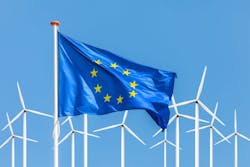Blowing Past Interconnection Inertia in EU: AWS, Accenture and WindEurope Testing EasyPermits Route
The road to net zero is paved with good intentions. Now think of the possible destination in that line.
Fighting for change can be hell. Creating a decarbonized energy grid is a goal of many cultures, particularly in Europe but they have the same challenge facing dozens of distributed and renewable energy projects being designed in the U.S.: Getting them from idea to construction to operations into the grid and/or localized loads.
The interconnection struggle is real. Projects are taking three to five to even eight years to go from application to commissioning, because of cross-jurisdictional red tape and a myriad of permitting delays.
A high percentage of those proposed projects die while waiting to be approved. Investors and developers can only hang on for so long.
Bureaucratic Headwinds vs. Aggressive CO2 Reduction Targets
“It’s not going to get any easier without some sort of market collaboration,” Kris Timmermans, a managing director and EMEA Renewables Lead at professional services and utilities consulting firm Accenture, said in an interview with EnergyTech. “It’s a real missed opportunity if we’re not looking at a streamlined process. That challenge could be overcome, but we’ll miss the opportunity if we do not work across EU Member states.”
Europe has even more aggressive decarbonization goals than anywhere in the world, but they also face a daunting number of snags along the way due to complex processes in permitting. The continent wants onshore and offshore wind to lead the way because it’s carbon-free and has higher capacity factors, but the old paperwork will drag it down.
To that end, Accenture has developed a partnership with cloud technology firm Amazon Web Services and industry advocate association WindEurope. Together they created and are piloting a digital, cloud-based permitting solution called EasyPermits.
Wind currently makes up close to 19% of the electricity generation resource portfolio in Europe, and European Commission leaders want to increase that to 50% by 2050. The lag time, however, is close to eight years for wind projects.
“Solving the permitting challenge and getting access to the electricity on European grids is now the number one bottleneck to deploying renewables at scale,” Malgosia Bartosik, Deputy CEO for WindEurope, told EnergyTech. “Across Europe, hundreds of GWs of wind energy projects have applied for a grid connection permit and are waiting for an answer. Grid saturation and inefficient grid planning are the major reasons for this slow deployment.”
Cross-border hurdles: A tale of many nations
Some of those are physical issues, some fiscal and, in some cases, it is simply old-fashioned process lost in translation as projects try to cross barriers and boundaries.
“Streamlining the process can come down to improving information management, increasing collaboration across sectors and providing transparency to all stakeholders on the process,” said Carol Yan, Europe, Middle East and Africa Head of Energy Transition and Renewables for Amazon Web Services (AWS).
The EasyPermits team developed a prototype in just under 12 weeks, then it built a pilot program for projects in Denmark and has ambitions to roll this out across EU Member States.
“You have permitting agents who have to process applications hundreds and thousands of pages long’ and they have to read them manually and flip every page of paper,” Yan pointed out. “With the cloud, you can jump forward to a word where things are automated: document checking, notifications, etc.
“Permitting agents in municipalities have collaboration needs with permitting agents nationally, with developers, government offices and public forums,” she added. “One user told us that in one region there are 80 different bodies that have to get involved. That’s a big way that digital tools can help.”
Time savings, instant response and interaction are needed. EasyPermits is a web-based solution where all documents are protected by cybersecurity yet it can also be quickly adapted and morphed in constant alignment toward a permitting goal.
Accenture’s Timmermans thinks EasyPermits can play a major in reducing the timeline down from eight years to two years in line with the Renewable Energy Directive on the continent. A big part of the lift is bringing the process into the 21st century with technologies likely with AI and cloud-based services.
“We’ve identified a road map for all the member states in Europe,” he said.
Improving the permitting flow across the pond
It may take several years to create a proof of concept throughout Europe, but once that hurdle is cleared the EasyPermits team believes it can streamline permitting in the U.S. Studies by the Berkeley National Lab and other researchers indicated that the interconnection queue in America can sometimes be as long as Europe’s.
Those include solar and storage projects as well as microgrids and wind power farms.
Even though the path of EasyPermits started with Europe and wind energy, other renewable technologies are due to follow. The average capacity factor for wind energy –or the ratio of actual electrical output compared with the unit’s capacity—is between 30 and 48%, virtually the same as hydropower and much higher than the solar PV average of 20%.
“Interconnectivity between different markets is also crucial for Europe’s energy transition,” WindEurope’s Bartosik pointed out. “The wind is always blowing somewhere. Having cross-border interconnectivity alleviates some of the congestion between countries and this already happens between countries. The European Commission wants EU Member States to do even more international trading because it optimizes the EU electricity market.”
EasyPermits is one possible way forward, given its collaboration between three major organizations all representing different parts of the energy market stream—design, generation and customer.
If it works there, perhaps it could work in the U.S. to break up the interconnection logjam impeding distributed energy resources which could help the commercial and industrial sectors reach decarbonization targets.
Track all moves in the C&I Energy Transition
Subscribe to EnergyTech's free E-Newsletter
About the Author
Rod Walton, EnergyTech Managing Editor
Managing Editor
For EnergyTech editorial inquiries, please contact Managing Editor Rod Walton at [email protected].
Rod Walton has spent 17 years covering the energy industry as a newspaper and trade journalist. He formerly was energy writer and business editor at the Tulsa World. Later, he spent six years covering the electricity power sector for Pennwell and Clarion Events. He joined Endeavor and EnergyTech in November 2021.
Walton earned his Bachelors degree in journalism from the University of Oklahoma. His career stops include the Moore American, Bartlesville Examiner-Enterprise, Wagoner Tribune and Tulsa World.
EnergyTech is focused on the mission critical and large-scale energy users and their sustainability and resiliency goals. These include the commercial and industrial sectors, as well as the military, universities, data centers and microgrids. The C&I sectors together account for close to 30 percent of greenhouse gas emissions in the U.S.
He was named Managing Editor for Microgrid Knowledge and EnergyTech starting July 1, 2023
Many large-scale energy users such as Fortune 500 companies, and mission-critical users such as military bases, universities, healthcare facilities, public safety and data centers, shifting their energy priorities to reach net-zero carbon goals within the coming decades. These include plans for renewable energy power purchase agreements, but also on-site resiliency projects such as microgrids, combined heat and power, rooftop solar, energy storage, digitalization and building efficiency upgrades.





